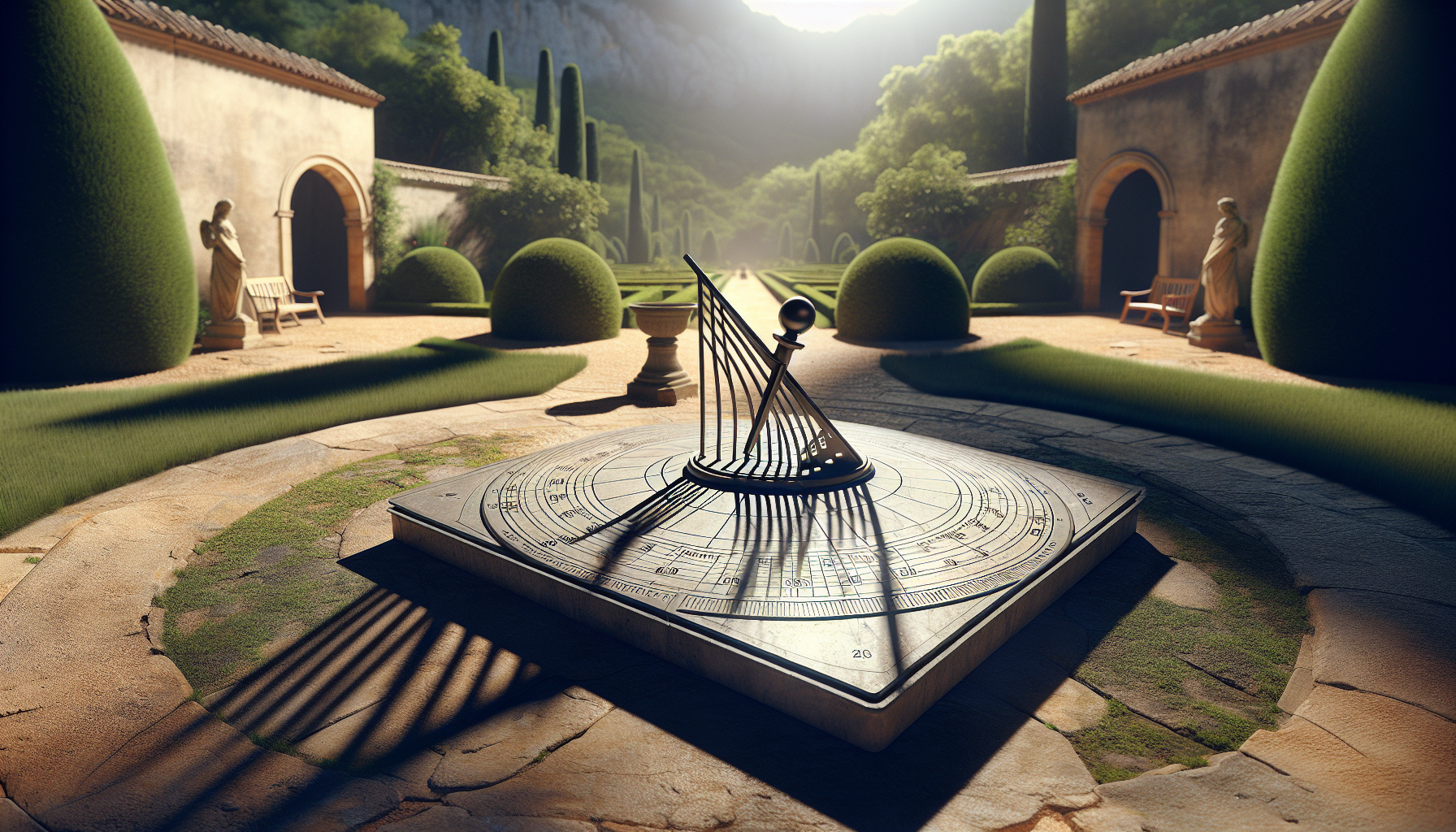In a world where every second counts and efficiency is the currency of success, mastering the art of timekeeping is more crucial than ever. Time is a relentless force that governs our lives, influencing every decision, every plan, and every action we take. But what if we could harness this elusive element, bending it to our will and using it to optimize our daily routines and long-term strategies? Welcome to the realm of ancient wisdom and modern innovation, where gnomons and shadow sticks—tools that trace their origins back thousands of years—reveal the secrets to precision and efficiency. 🌟
At first glance, the terms “gnomons” and “shadow sticks” might evoke images of dusty relics buried in the annals of history, far removed from the sleek digital devices that dominate our modern landscape. However, these ancient instruments hold timeless lessons in understanding and mastering time. Gnomons, the upright parts of sundials, and shadow sticks, their simpler cousins, have been used since antiquity to measure the passage of time with remarkable accuracy. Their enduring legacy is not just in their ability to tell time but in the profound insights they offer into the natural rhythms of the world. As we delve into their history and functionality, we’ll uncover how these seemingly primitive tools can enhance our precision and efficiency today.
In our exploration, we’ll journey through time—literally and metaphorically—beginning with the fascinating history of these tools. From the sun-drenched plains of ancient Egypt to the bustling marketplaces of medieval Europe, gnomons and shadow sticks have played pivotal roles in shaping societies and cultures. Their evolution is a testament to human ingenuity and our relentless pursuit of understanding time. We’ll discover how different civilizations adapted these tools to suit their unique needs, leading to innovations that paved the way for modern timekeeping devices.
As we transition from history to practicality, we’ll explore the mechanics of gnomons and shadow sticks. How do these simple yet ingenious devices harness the sun’s rays to mark time with such precision? What principles of physics and astronomy do they employ, and how can we apply these principles in our daily lives? By demystifying the science behind these tools, we empower ourselves with knowledge that transcends the limitations of digital clocks and calendars. This understanding not only enhances our appreciation of ancient technology but also equips us with strategies to improve our efficiency and productivity.
Finally, we’ll bridge the gap between ancient wisdom and contemporary application, exploring innovative ways to integrate these principles into our modern routines. Whether it’s through personal productivity techniques, business strategies, or even environmental sustainability efforts, the lessons gleaned from gnomons and shadow sticks offer valuable insights into optimizing time use. We’ll discuss practical tips and strategies for incorporating these timeless concepts into your daily life, transforming the way you perceive and manage time. By the end of this journey, you’ll be equipped with a new perspective on time—one that empowers you to achieve greater precision and efficiency in all your endeavors. 🌞
Join us as we unravel the mysteries of time, guided by the shadows cast by gnomons and shadow sticks. Through this exploration, you’ll not only gain a deeper understanding of these ancient tools but also unlock the potential to master time itself, enhancing both your personal and professional life. Let’s embark on this captivating journey into the heart of timekeeping, where the past meets the present, and where ancient wisdom illuminates the path to modern success.
Understanding the Historical Significance of Gnomons and Shadow Sticks
Since ancient times, humans have been fascinated by the concept of time. The earliest civilizations relied on natural phenomena to track time, with gnomons and shadow sticks being among the first tools invented for this purpose. These simple yet ingenious devices laid the foundation for our modern understanding of timekeeping. A gnomon is essentially a stick or pole placed upright in the ground, its shadow moving in response to the sun’s position in the sky. As the earth rotates, the shadow cast by the gnomon shifts, allowing observers to track the passage of time. Shadow sticks, similar in concept, were often used by various cultures to mark time intervals during the day.
The use of gnomons and shadow sticks was prevalent in ancient Egypt, Mesopotamia, and China, where they served as rudimentary sundials. The Egyptians, for instance, utilized obelisks as giant gnomons, their shadows indicating the time of day. In Mesopotamia, shadow sticks were placed in specific arrangements to track solar and lunar cycles, aiding in agricultural planning and religious ceremonies. The ancient Chinese also made significant advancements in the use of shadow sticks, integrating them into complex water clocks for more precise timekeeping.
Over the centuries, these early timekeeping devices evolved, paving the way for more sophisticated instruments. The understanding of gnomons and shadow sticks was crucial in the development of trigonometry and astronomy. By observing the angles and lengths of shadows, ancient scholars could calculate the position of celestial bodies, contributing to the advancement of scientific knowledge. The historical significance of gnomons and shadow sticks cannot be overstated, as they represent humanity’s enduring quest to measure and master time. Their legacy is evident in modern sundials and the continued use of shadows in various scientific applications.
The Science Behind Gnomons: Harnessing Solar Shadows
Gnomons work on a straightforward yet effective principle: as the sun moves across the sky, it casts a shadow on the ground, which moves in a predictable pattern. By studying these shadows, one can determine the time of day and even the season. This principle is based on the earth’s rotation and tilt, as well as the sun’s apparent motion in the sky. When constructing a gnomon, it’s essential to place it in a location where it will receive ample sunlight and ensure that it is perfectly vertical to produce accurate readings.
The science of gnomons is deeply intertwined with geometry and astronomy. As the sun travels from east to west, the shadow of a gnomon traces a curve on the ground, which can be mapped using mathematical equations. This curve, known as the shadow path, changes with the seasons due to the tilt of the earth’s axis. During summer, the sun is higher in the sky, resulting in shorter shadows, while in winter, the sun is lower, creating longer shadows. Understanding this relationship allows for the precise design of sundials, which use gnomons to mark specific time intervals throughout the day.
One of the most remarkable aspects of gnomons is their ability to indicate geographical directions. When a gnomon is aligned with the Earth’s rotational axis, its shadow can accurately point towards true north at noon. This property made gnomons invaluable for navigation and exploration in ancient times. Furthermore, by analyzing the angles of the shadow at different times, ancient astronomers could calculate the Earth’s circumference and tilt, contributing to our understanding of the planet’s size and orientation in space. The science of gnomons is a testament to human ingenuity and our capacity to harness natural phenomena for practical purposes.
Comparative Analysis: Gnomons vs. Modern Sundials
| Aspect | Gnomons | Modern Sundials |
|---|---|---|
| Design | Simple vertical sticks or poles | Complex designs with calibrated hour lines |
| Precision | Dependent on placement and angle | Highly precise with adjustments for latitude |
| Usage | Basic time and direction indication | Accurate timekeeping and aesthetic appeal |
| Historical Significance | Foundation for timekeeping and astronomy | Evolution of ancient techniques |
As you can see from the table above, while gnomons provided the groundwork for timekeeping, modern sundials have refined and expanded upon these principles, offering greater precision and functionality. For an in-depth exploration of how modern sundials are constructed and calibrated, watch the video below:
Watch: Sundials – A Journey Through Time by Sundial Enthusiasts Channel
Integrating Shadow Sticks into Everyday Life
In contemporary times, the use of shadow sticks might seem antiquated, yet their principles remain relevant in various fields. By understanding the mechanics of shadow movement, individuals can harness these tools for personal and professional applications. In gardening, for example, shadow sticks can help determine the best placement for plants based on sunlight exposure, optimizing growth conditions. Similarly, in architecture, shadow studies are conducted to evaluate the impact of new structures on sunlight penetration, ensuring that buildings are designed with natural lighting efficiency in mind.
Shadow sticks also find applications in education, where they serve as interactive tools for teaching basic geometry and astronomy concepts. By constructing simple shadow sticks, students can engage in hands-on learning, observing the relationship between angles, shadow lengths, and time. This experiential approach not only enhances understanding but also fosters a deeper appreciation for the interconnectedness of science and nature. Additionally, the simplicity of shadow sticks makes them accessible to learners of all ages, encouraging curiosity and exploration.
Moreover, shadow sticks can be utilized in cultural and artistic expressions. In some traditions, shadow play is an integral part of storytelling and performance art, using shadows cast by sticks to create visual narratives. This ancient form of entertainment highlights the creative potential of shadows, offering audiences a unique and immersive experience. By integrating shadow sticks into various aspects of life, individuals can tap into the timeless wisdom of our ancestors, finding inspiration and utility in this age-old practice.
Benefits of Using Shadow Sticks Today
- Cost-effective and sustainable timekeeping method
- Educational tool for teaching astronomy and geometry
- Enhances understanding of natural light patterns
- Inspires creativity in art and storytelling
As we continue to explore the applications of shadow sticks in modern contexts, it becomes evident that these simple tools offer a multitude of benefits, enriching our lives both practically and creatively. To learn more about the contemporary uses of shadow sticks, consider exploring online resources and communities dedicated to this fascinating subject.

Conclusion
Conclusion: Mastering Time: Unleashing the Power of Gnomons and Shadow Sticks for Precision and Efficiency
In this comprehensive exploration of the timeless art of mastering time through gnomons and shadow sticks, we have journeyed through history, science, and practical applications to illuminate the profound impact these ancient tools have on our modern understanding of timekeeping. As we conclude, let’s revisit the key points covered, underscore the significance of the topic, and inspire action among readers.
Historical Significance and Evolution
Our discussion began with the historical context of gnomons and shadow sticks, tracing their origins back to ancient civilizations such as Egypt and Mesopotamia. These cultures recognized the importance of celestial movements, harnessing the sun’s shadows to create the first primitive yet remarkably accurate timekeeping devices. By understanding the evolution of these instruments, we gain insight into the ingenuity of our ancestors and their profound influence on modern science and technology.
Scientific Principles at Play
Central to our exploration was the scientific foundation underpinning gnomons and shadow sticks. These devices rely on the Earth’s axial tilt and its orbit around the sun, translating celestial phenomena into measurable time units. We delved into the geometry of shadows, understanding how variations in length and direction provide precise temporal information. This intersection of science and art underscores the elegance and simplicity of shadow-based timekeeping.
Modern Applications and Technological Advancements
While rooted in antiquity, the principles of gnomons and shadow sticks have transcended time, finding relevance in today’s technology-driven world. We examined how modern adaptations have enhanced accuracy and usability, integrating with advanced technologies such as GPS and atomic clocks. This fusion of ancient wisdom and contemporary innovation offers a compelling perspective on how we can harness both historical knowledge and cutting-edge technology for improved time management and efficiency.
Cultural and Philosophical Reflections
Beyond their practical utility, gnomons and shadow sticks invite us to reflect on our relationship with time. They encourage mindfulness and an appreciation for the natural rhythms of the universe. As we navigate a fast-paced, digital age, these tools remind us to pause, observe, and align ourselves with the larger cosmic dance. This philosophical dimension enriches our understanding and fosters a deeper connection to the world around us.
Empowering Individuals and Communities
The empowering potential of mastering time through these ancient techniques cannot be overstated. By adopting these practices, individuals can enhance their productivity, prioritize tasks effectively, and achieve a balanced lifestyle. Communities can also benefit, fostering a shared appreciation for the passage of time and its impact on collective endeavors. Encouraging engagement with these methods cultivates a culture of precision and efficiency, ultimately contributing to personal and societal growth.
Call to Action
As we conclude this exploration, the importance of mastering time using gnomons and shadow sticks becomes evident. The knowledge and insights gained from this article equip you with valuable tools to navigate the complexities of modern life. We urge you to reflect on your current time management practices and consider integrating these ancient techniques into your daily routine. Experiment with a shadow stick or explore the geometric beauty of a sundial. Share your experiences and insights with others, fostering a community of learners and enthusiasts.
To deepen your understanding, we encourage further exploration through reputable sources such as the British Sundial Society and the North American Sundial Society, where you can find additional resources and engage with fellow enthusiasts. By sharing this article, you contribute to a broader conversation about timekeeping and inspire others to explore the elegance of gnomons and shadow sticks.
In closing, let this article be a catalyst for inspiration and action. Mastering time is not just about efficiency; it’s about embracing a timeless connection to the universe. By integrating the wisdom of the past with the innovation of the present, we unlock the potential for a more harmonious and productive future. Thank you for embarking on this journey with us—now, let’s make every moment count! ⏳✨
Toni Santos is a visual storyteller and cosmic interpreter whose work illuminates the ancient skywatchers and their prehistoric astronomy—the profound ways early humans observed and revered the heavens before written history. Through a visionary lens, Toni explores how the stars, planets, and celestial cycles shaped myth, ritual, and survival in cultures lost to time.
Rooted in a fascination with archaic observatories, stone alignments, and celestial symbolism, Toni’s creative journey reveals the deep human impulse to understand and harmonize with the cosmos. From lunar phases guiding planting seasons to the sacred paths of the Milky Way, each of his works embodies the awe and knowledge encoded in the night sky.
Combining artistic craftsmanship with archaeological insight, Toni’s pieces evoke the mystery and precision of prehistoric astronomers. His work does more than depict—it channels the timeless dance between earth and sky, bridging ancient wisdom with contemporary wonder.
As the visionary behind Vizovex, Toni shares curated visuals, essays, and symbolic studies that invite others to reconnect with the cosmic heritage written in stone and starlight. His creations are a call to look upward, to listen to the silent stories told by the stars, and to honor the first astronomers who mapped the heavens with reverence and ingenuity.
His work is a tribute to:
The celestial wisdom of prehistoric peoples
The sacred geometry of ancient observatories
The enduring bond between human culture and the cosmos
Whether you’re a stargazer, a scholar of ancient mysteries, or someone captivated by the universe’s earliest storytellers, Toni welcomes you to journey through a space where the sky is both map and myth—one constellation, one ritual, one revelation at a time.




